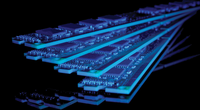
Lead Image © Denis Dryashkin, 123RF.com
NVDIMM and the Linux kernel
Steadfast Storage
Many databases, such as Berkeley DB, Oracle TimesTen, Apache Derby, and MySQL Cluster, can be configured to run completely in their host's main memory. SAP HANA is even an in-memory-only database. Such products are used when you need a quick response despite high workload. Classic high-performance computing also likes to keep work data in RAM on the node so that CPUs do not have to wait too long for data from mass storage.
Because RAM content is always lost in a shutdown or failure, such systems need to be backed up periodically to a non-volatile medium, although it's not especially reliable in practice and can slow the entire system. Non-volatile RAM would be valuable, and it is coming to market soon as non-volatile DIMM (NVDIMM). The role model was buffer cache memory on RAID controllers, which kept its content when switching off the system to ensure the integrity of its data.
In December 2015, the JC-45 subcommittee of the JEDEC industry association [1] published specifications for persistent memory modules that fit the sockets for DDR4 SDRAM DIMMs. However, motherboards need a BIOS that supports the modules. JEDEC envisages two approaches: NVDIMM-N backs up the content of its DRAM in case of a power outage and restores the data when the voltage is restored. NVDIMM-F behaves like an SSD attached to the memory bus.
Useful Hybrids
NVDIMM is a wanderer between two worlds. Easily confused with the appearance of DDR4 modules (Figure 1), only a backup capacitor (often larger), batteries in some cases, and a flash chip reveal its strange features. If you need to shut down the server, the capacitors or batteries buffer the content of the module until it is completely written to the flash chips. Newer technologies even promise to remove this step by making flash fast enough for
...Buy this article as PDF
(incl. VAT)
Buy ADMIN Magazine
Subscribe to our ADMIN Newsletters
Subscribe to our Linux Newsletters
Find Linux and Open Source Jobs
Most Popular
Support Our Work
ADMIN content is made possible with support from readers like you. Please consider contributing when you've found an article to be beneficial.



